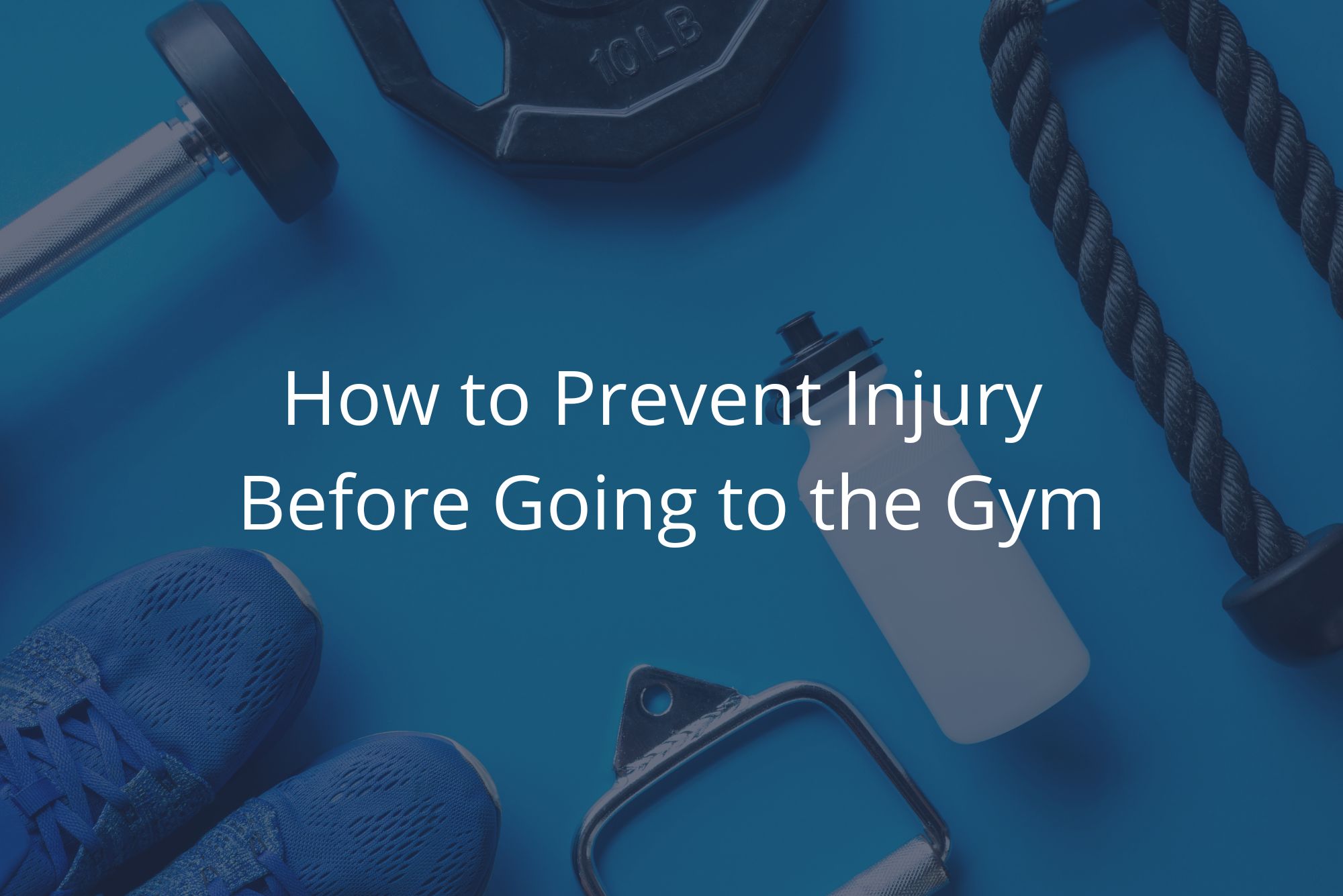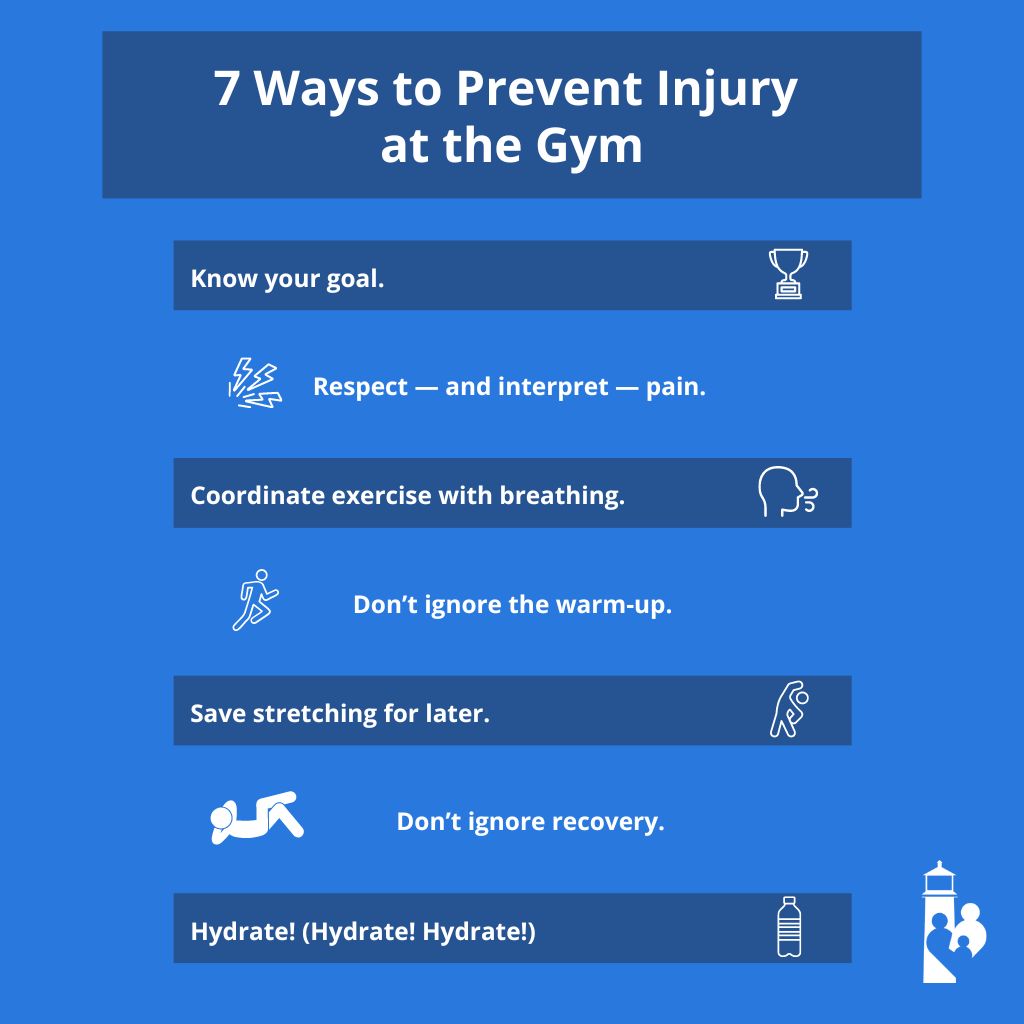
People go to the gym to feel better, not worse. Too often, though, our efforts at the gym end up hurting us. About half of my patients who go to the gym regularly have ended up with an injury… and those injuries are almost always avoidable.
While an average 20-year-old can usually do anything in the gym without pain, individuals beyond their 30s can inflict a lot of damage if they don’t respect their own underlying physical problems. Whether you’re competitive and trying to keep up with people 35 years younger than you in your fitness class, or you’re doing types of exercises that aren’t good for your body, it’s time to reassess how you’re approaching exercise.
The goal is to be challenged, but attuned to harmful activity. It’s time to unlearn “no pain, no gain.” Let these seven steps show you how to prevent injuries at the gym!
Step 1: Know your goal.
Before you even set foot in the gym, know what you want to get out of it. Knowing your goal is like shopping with a grocery list; it keeps you focused and in the right aisles. Maybe you want to be able to play with your grandkids, lose weight, build muscle mass, or reduce aches and pain.
Don’t be afraid to get granular with this mental sort. Say you want to train for a marathon; break that down further. Do you want to improve your time from a previous rate, or do you want to simply finish? Whatever the answer, differentiating your goal will dictate what specifically you do in the gym and how to prevent injuries.
Step 2: Respect — and interpret — pain.
Pain is a message that you need to both respect and understand. Searing, sharp pain usually means, “stop!” But aching pain may just mean the muscle is tired.
Pushing through meaningful pain is a good way to hurt yourself. However, pain doesn’t necessarily mean you need to stop exercising or halt your physical progress. It can be a signal to modify your activities.
Let’s say you have a shoulder injury, and you’re doing push-ups. Your shoulder might object to the traditional push-up position. Fortunately, you can modify the push-up in such a way — leaning against a chair or making contact on the floor with your knees — that you still get the benefits of the exercise without the strain on your shoulder.
A physical therapist trainer can be a useful resource in helping you discover the right kinds of exercise for you based on your pain and challenges.
Step 3: Coordinate exercise with breathing.
Be mindful of how (or if!) you’re breathing during exercise.
If you hold your breath during exercise, your muscles will tense up and cause more potential for injury. You also have a build-up of acid when you don’t breathe; when your oxygen level goes down, you get dizzy. You could injure yourself from both over-tensing and passing out.
An easy way to stay on top of your breath is to remember to exhale during exercise.
Step 4: Don’t ignore the warm-up.
Warm muscles don’t tear as easily as cold ones. To warm up prior to working out, you can do minor, low-impact activities that gently elevate your heart-rate and warm your muscles. You can also apply heat through heating pads or saunas.
Step 5: Save stretching for later.
You’ll get the most benefit from stretching if you stretch after your workout. Stretching afterward means you’re stretching warm muscles, which makes them stronger and more flexible.
Just like with exertion, it’s helpful to coordinate your stretches with breathing. Stretch on the exhale, and don’t bounce while you stretch. Instead, stretch gradually and hold the posture for 10 seconds.
However, it’s important to keep from stretching through injuries. Any pain you’re feeling means your muscles are trying to repair themselves, and stretching literally tears muscle fibers slightly, resulting in further injury.
Step 6: Don’t ignore recovery.
It’s crucial to give your body time to repair and recover. Every week, give yourself two or three days without extreme exertional activity. You can still move or do light exercise, but refraining from high exertion allows your system time to reset, and it lowers the likelihood of injury.
I like to give the example of a relief pitcher who’s exerting for 100 pitches. That’s all they do. But if they do those 100 pitches in a competitive mode, day after day without a break, they will get hurt. And these are athletes who are in the best shape possible. So give yourself at least two days of rest each week without physical strain.
Another aspect of recovery is to apply ice after strenuous exercise. If you’ve just finished playing tennis for two hours, and you have an underlying shoulder issue, ice your shoulder.
Step 7: Hydrate! (Hydrate! Hydrate!)
Hydration is a critical component of a functional immune system. Being hydrated aids in recovery. It gets necessary vitamins and minerals moving to the right places. It keeps your blood pressure appropriate. It also clears lactic acid buildup, and lets the kidneys and liver do what they need to do.
You should drink between 0.5 and 1 ounce of water per pound of body weight per day. If you’re doing a large amount of strenuous activity, you’ll need even more.
Remember How to Prevent Injuries at the Gym
Going to the gym is a common way to stay healthy, and practicing these tips on how to prevent injuries should be, too. From monitoring pain to taking time for warm up and recovery, every step in this list will help you move toward your fitness goals without the roadblock of an injury.

Dr. David Rosenberg
Dr. Rosenberg is a board-certified Family Physician. He received his medical degree from the University of Miami in 1988 and completed his residency in Family Medicine at The Washington Hospital in Washington, Pennsylvania in 1991. After practicing Emergency Medicine at Palm Beach Gardens Medical Center for two years, he started private practice in Jupiter, in 1993. He is an avid baseball fan and Beatles fanatic, since he was 8 years old. He has been married to his wife, Mary, since 1985 and has three grown children.
David completed additional studies at Mercer University, Macon, Georgia and obtained a BS in Chemistry in 1983.
“My interests include tennis, snow skiing, Pilates and self-development.”

